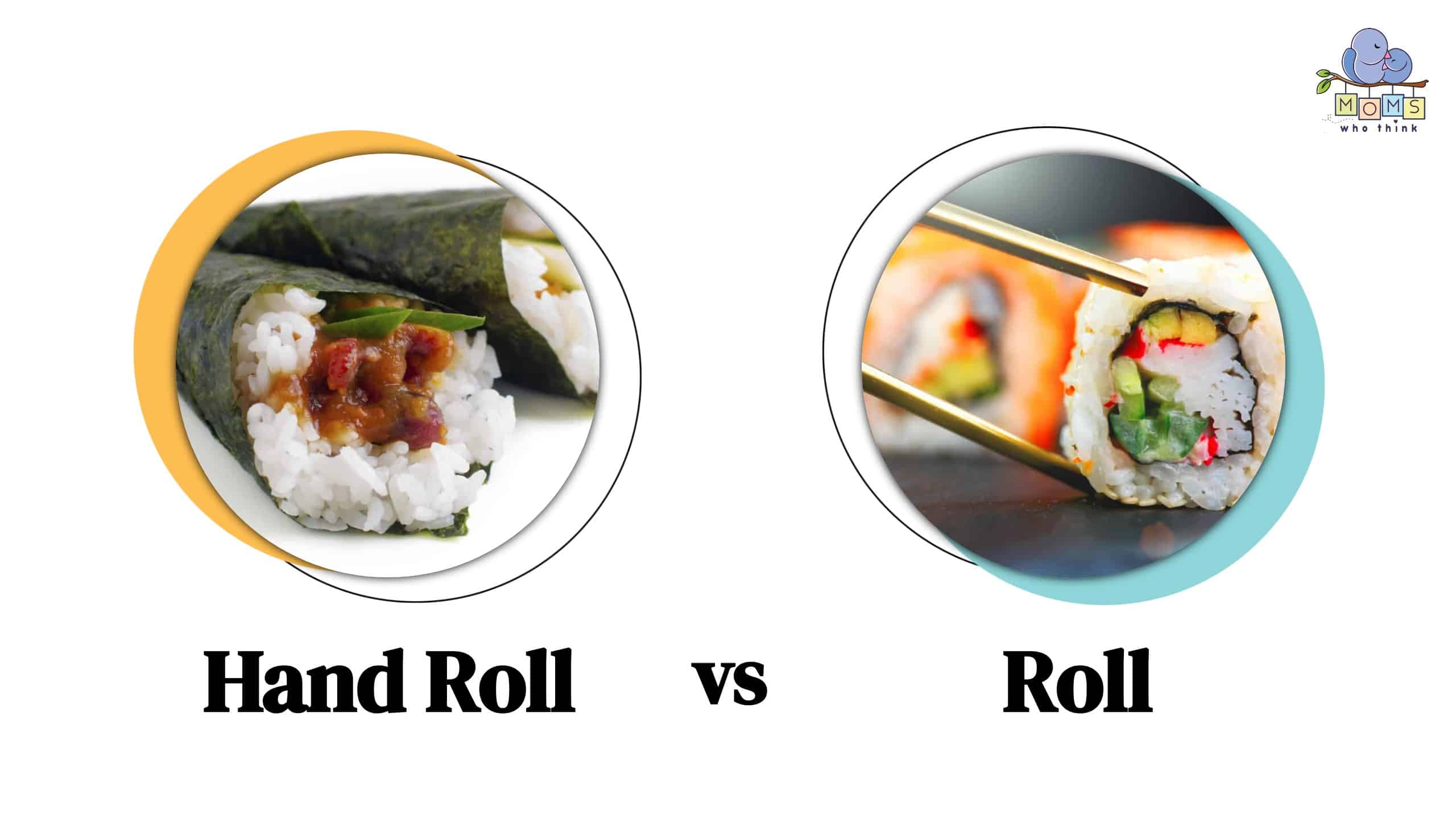Got picky kids? Tired of the same boring weeknight dinners? Can’t figure out what food to grab while you’re on the go? Looking for tasty and nutritious meal options for your family? Well, if you answered yes to at least one of the questions, you’ve come to the right place!
Sushi is a trendy topic in America because of its versatility. Still, for some Americans who hear the word sushi, they immediately think of eating raw fish. However, that’s not the only kind of sushi. In this article, you will learn what sushi is, different types of sushi styles, hand roll vs. roll, and why knowing the differences can take your family’s meals to the next level! But first, let’s talk about…
What is Sushi?
The word sushi (pronounced “soo-shi”) in Japanese means “sour rice.” But what’s surprising for many is that while Japan is known as the sushi capital of the world, sushi didn’t get its start in Japan.
In fact, sushi had its early beginnings in the rice fields of Southeast Asia, such as China. During that time, the dish was called narezushi (pronounced nah-ray-zoo-shi) and consisted of fermenting the rice to prevent freshwater fish from spoiling. The fish was also heavily salted to prevent bacterial growth, especially since there was no refrigeration. And fish could last for a longer period of time.
And as the years went by, knowledge of this process grew throughout Asia, including Japan. For instance, the first written reference to “sushi” in Japan appears in the year 718. Each region of Asia added its own preservation techniques to suit their tastes and needs better.
- The must-have convenient reference guide for every home cook!
- Includes more than 8,000 substitutions for ingredients, cookware, and techniques.
- Save time and money on by avoiding trips to grab that "missing" ingredient you don't really need.
Why is Sushi So Popular?
Thanks to Japan’s creative chefs, a wide variety of flavors and dishes become convenient and delicious! With exciting and tasty assortments, such can be enjoyed in many creative ways that have captured hearts globally. Especially American households!
Now that you know Sushi’s background, let’s dive into the differences between hand roll vs. roll sushi.
Not All Sushi is Created Equal
The broad term for sushi rolls is Makizushi (pronounced Mah-kee-zoo-shi) and can be divided into 4 categories. The first one is…
Hand Roll
Also known as temaki (pronounced Tah-mah-kee) sushi. It’s called a “hand roll” because it is made of a rolled cone of seaweed (think of a waffle ice cream cone) wrapped around vinegared rice and a variety of tasty fillings of your choice. Why?
Because there are no rules as to what you can put inside the roll, it doesn’t have to be raw fish or some other seafood.
It’s like making your own sushi taco! And it’s a fun activity that brings the whole family together! Plus, this gives your kids the opportunity to become mini-chefs! It’s a time to bond with food, laughter, and a lot of yum!
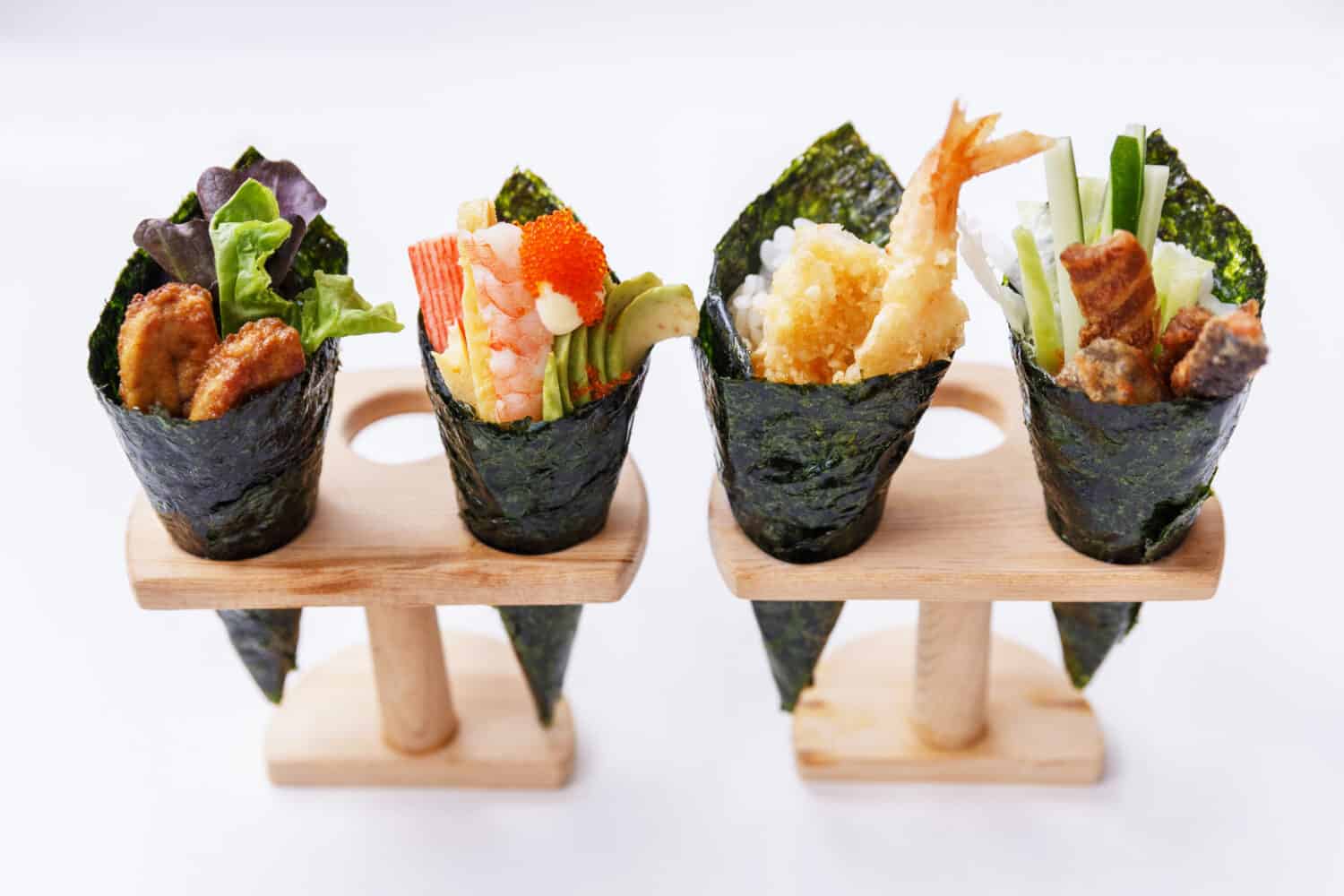
©Artit Wongpradu/Shutterstock.com
The way to eat this type of sushi is usually with your hand rather than chopsticks. Kids enjoy holding their own ice cream cone-shaped dish, especially when filled with their favorites!
In fact, take a look at these ingredients that give you ideas on what to include for your own mouthwatering hand rolls wrapped in seaweed. Combinations such as…
- Avocado, carrot matchsticks, a sprinkle of sesame seeds, and add a citrusy sauce.
- Ripe mango slices, julienned red bell peppers, shredded lettuce, cilantro, and lime.
- Roasted red peppers, kalamata olives, crumbled feta cheese, a dash of oregano with olive oil drizzled over the top, and a squeeze of lemon.
- Shredded cabbage, julienned carrots, crispy bean sprouts, and chopped scallions with a ginger-sesame dressing on top.
Keep in mind the cone-shaped seaweed can get soggy pretty fast. So make sure you eat it sooner than later!
Bottom line: These delightful cone-shaped hand roll ideas showcase a variety of flavors, textures, and creative combinations with the option to include fish, making this a perfect sushi experience. And you can include any sushi-grade fish of your choice, such as tuna or salmon. Most local Asian stores will have them.
Now let’s talk about the other 3 kinds of well-known Makizushi that are available throughout America.
Roll – Bite-sized Yum
“Maki” is the shortened term for Makizushi and is the catch-all term for sushi rolls. Sushi rolls are made from a thin seaweed sheet called “nori” and wrapped around a layer of rice, veggies, and sometimes fish. Then, they are rolled up using a special bamboo mat and cut into bite-size pieces.
Hosomaki (pronounced “ho-so-mah-ki) are thin sushi rolls consisting of rice and just one other ingredient.
Futo-maki (pronounced “fu-toe-mah-ki) are made thicker rolls because they have more ingredients.
Saiku-maki (pronounced “sigh-ku-mah-ki) is also known as decorative rolls, giving you a beautiful visual presentation! The sushi rolls are displayed in shapes of flowers or other forms of art. If you want to impress sushi lovers at your next gathering, saiku-maki is the way to go!
Keep in mind rolls can also be prepared using the “inside out” method. You may have seen it where the nori wraps the center of the roll and the rice sticks on the outside.
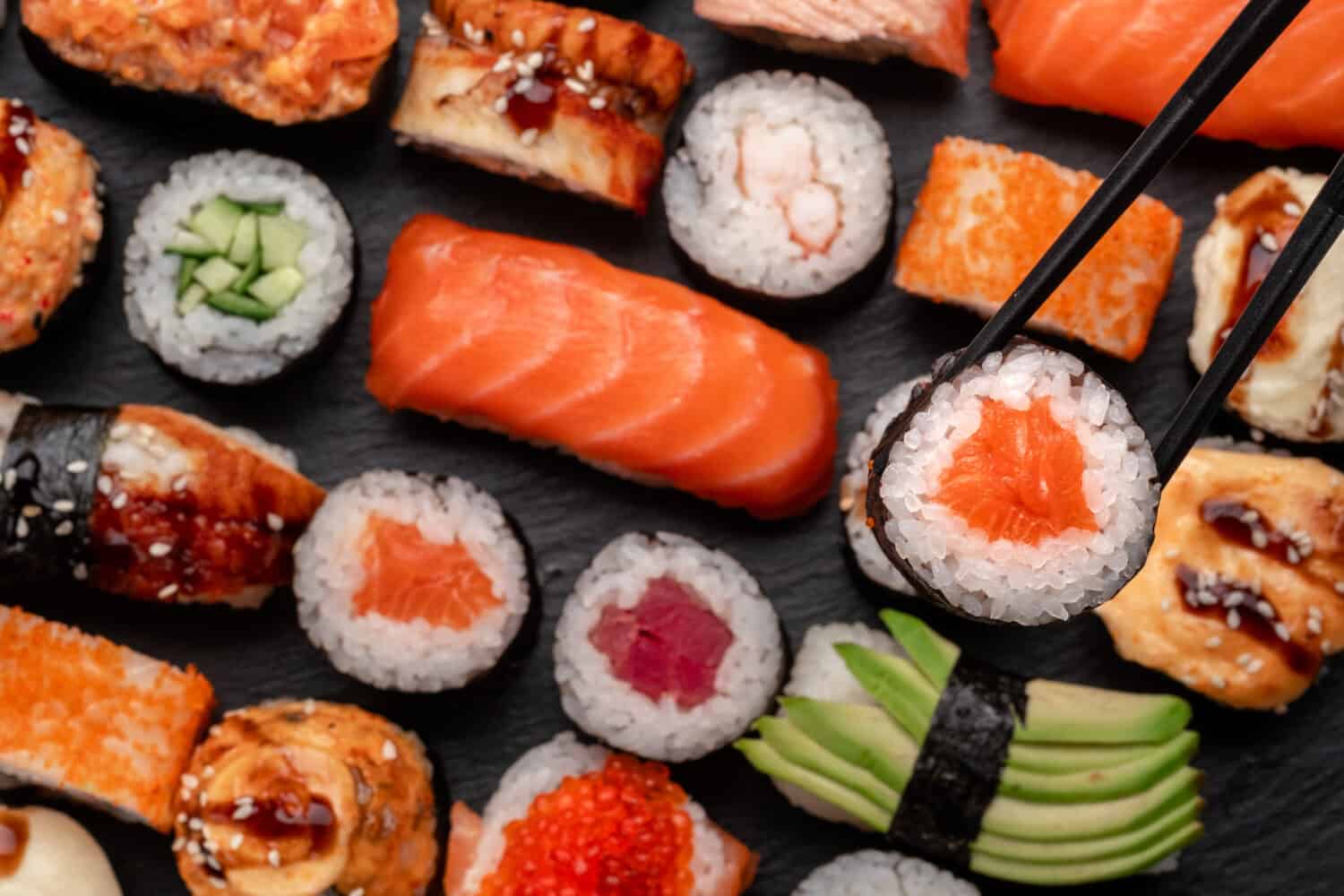
©Andrei Iakhniuk/Shutterstock.com
No matter the look, sushi rolls use rice as the main staple. You just choose what you want to go on the inside!
- The must-have convenient reference guide for every home cook!
- Includes more than 8,000 substitutions for ingredients, cookware, and techniques.
- Save time and money on by avoiding trips to grab that "missing" ingredient you don't really need.
Check out the top 10 sushi rolls enjoyed by many Americans:
- California Roll: This roll has imitation crab, avocado, and cucumber strips inside with rice wrapped on the outside.
- Spicy Tuna Roll: Imagine a tuna salad with a spicy twist, all rolled up with rice.
- Philadelphia Roll: Filled with cream cheese and smoked salmon. It’s like a tasty bagel but in sushi form!
- Cucumber Roll: Just like the name! Cucumber strips inside the rice and seaweed.
- Avocado Roll: Full of avocado and all the creamy goodness.
- Shrimp Tempura Roll: Crispy fried shrimp, cucumber, and sometimes avocado inside.
- Spicy Salmon Roll: Like the spicy tuna roll, salmon is the star and comes with a spicy kick.
- Dragon Roll: It's like an eel and avocado sandwich, rolled up and topped with more thinly sliced avocado.
- Rainbow Roll: A colorful roll with fresh fish on top of a California roll (see #1), making it look like a rainbow.
- Shrimp California Roll: This is a combination of shrimp tempura with the classic California roll ingredients for a tasty savory mix!
You can find these sushi rolls and others in many Asian-infused restaurants across America. With lots of flavors and textures, you’re sure to enjoy the many options available!

Bottom line: Sushi rolls are great for those busy weeknights when stomachs are growling! Sushi rolls become the superhero of convenience! From classic rolls like the California roll or the Dragon roll, all are pre-cut into bite-sized pieces. This makes them the perfect choice for quick family dinners or school lunches!
Health Benefits
While there are distinct differences between hand roll vs. roll sushi, the health benefits are the same. It provides nutrient-dense seaweed. And when you choose lean protein, health-boosting veggies, and other heart-healthy fillings, sushi can be a great choice for the American diet. In fact, research shows can help gut, thyroid, and immune health!
One Last Thought
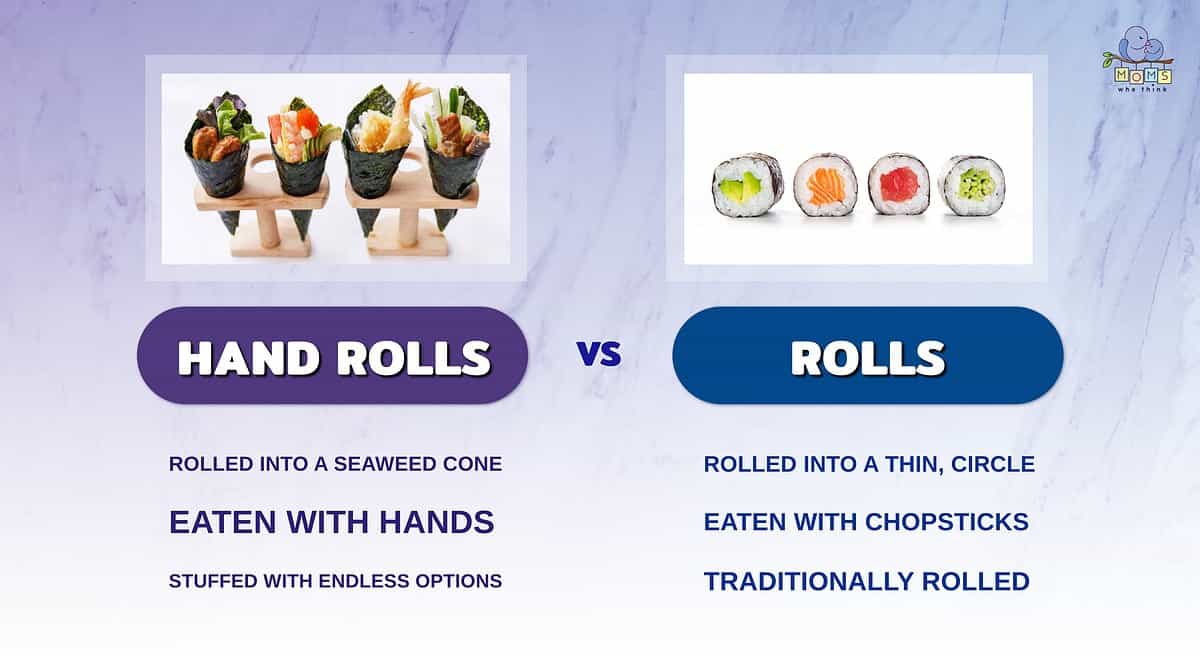
Sushi has been a favorite among people all over the world. And with its many tasty flavors and textures, there are options for just about anyone. Whether you enjoy hand rolls or the traditional sushi roll, there's something for everyone.
- The biggest difference between hand rolls and sushi rolls is the shape. Hand rolls are more like a cone, whereas traditional sushi rolls are tightly rolled.
- Traditional sushi rolls are typically eaten with chopsticks, while rolls are eaten with hands (making it fun for kids to enjoy).
- Hand rolls can potentially get a little messy as it's filled with veggies and seafood, among other options. Conversely, rolls are neatly packed and sliced, allowing everything to stay in place.
So now that you understand the different types of sushi rolls, you know it isn’t a matter of preference. This is your invitation to explore flavors, create fun family memories, and open your eyes to the endless possibilities of quick, tasty, and nutritious out-of-the-box dining options!
Think of the difference between hand roll vs. roll as two exciting paths to the flavor town of sushi. The hand roll method lets you be the chef, making your own tasty cone with all your favorites. On the other hand, the roll method gives you a treasure trove of flavors in every neatly sliced piece that’s like a symphony of tastes in each bite. Whichever you decide, you can put your family on a one-way ticket to Yumville!
Print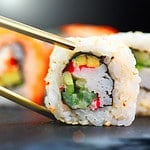
Sushi
Ingredients
For the Sushi Rice:
- 1 cup sushi rice
- 2 cups water
- 1/4 cup rice vinegar
- 2 tablespoons sugar
- 1 teaspoon salt
For the Sushi Filling (Choose one or more):
- Sushi-grade raw fish (such as tuna or salmon), thinly sliced
- Cooked and seasoned shrimp
- Avocado, thinly sliced
- Cucumber, thinly sliced into matchsticks
- Carrot, thinly sliced into matchsticks
- Cream cheese, thinly sliced (for a Philadelphia roll)
- Seaweed (Nori) sheets
- Soy sauce, pickled ginger, and wasabi for serving
Equipment:
- Bamboo sushi rolling mat (Makisu)
- Plastic wrap or a plastic food storage bag
Instructions
1. Prepare the Sushi Rice:
- Rinse the sushi rice under cold running water until the water runs clear.
- Combine the rinsed rice and water in a saucepan and bring to a boil. Reduce the heat to low, cover, and simmer for about 15-20 minutes, or until the rice is tender and the water is absorbed.
- In a small saucepan, heat the rice vinegar, sugar, and salt over low heat until the sugar and salt dissolve. Remove from heat.
- Transfer the cooked rice to a large bowl and while it's still hot, add the seasoned rice vinegar. Gently mix and fan the rice to cool it down while maintaining a glossy appearance. Cover with a damp cloth to keep it moist.
2. Prepare the Sushi Fillings:
- Slice your chosen fillings into thin strips or pieces, ensuring they are long enough to fit across the width of your seaweed sheets.
3. Assemble the Sushi:
- Lay a bamboo sushi rolling mat on a clean surface and cover it with plastic wrap or a plastic food storage bag to prevent sticking.
- Place a sheet of seaweed (Nori) on top of the plastic wrap with the rough side facing up.
4. Add Sushi Rice:
- Wet your hands with water to prevent the rice from sticking. Take a handful of sushi rice (about the size of a small apple) and spread it evenly over the seaweed, leaving about half an inch of seaweed on one edge.
5. Add Fillings:
- Place your chosen fillings on top of the rice, near the center of the seaweed sheet.
6. Roll the Sushi:
- Using the bamboo mat, carefully lift the edge of the seaweed closest to you and fold it over the fillings, tucking it tightly.
- Continue rolling away from you while applying gentle pressure to create a cylindrical sushi roll.
- Wet the exposed edge of the seaweed with a bit of water to seal the roll.
7. Slice and Serve:
- Use a sharp, wet knife to slice the sushi roll into bite-sized pieces. Dip the knife in water between cuts to prevent sticking.
- Serve your homemade sushi with soy sauce, pickled ginger, and wasabi.
